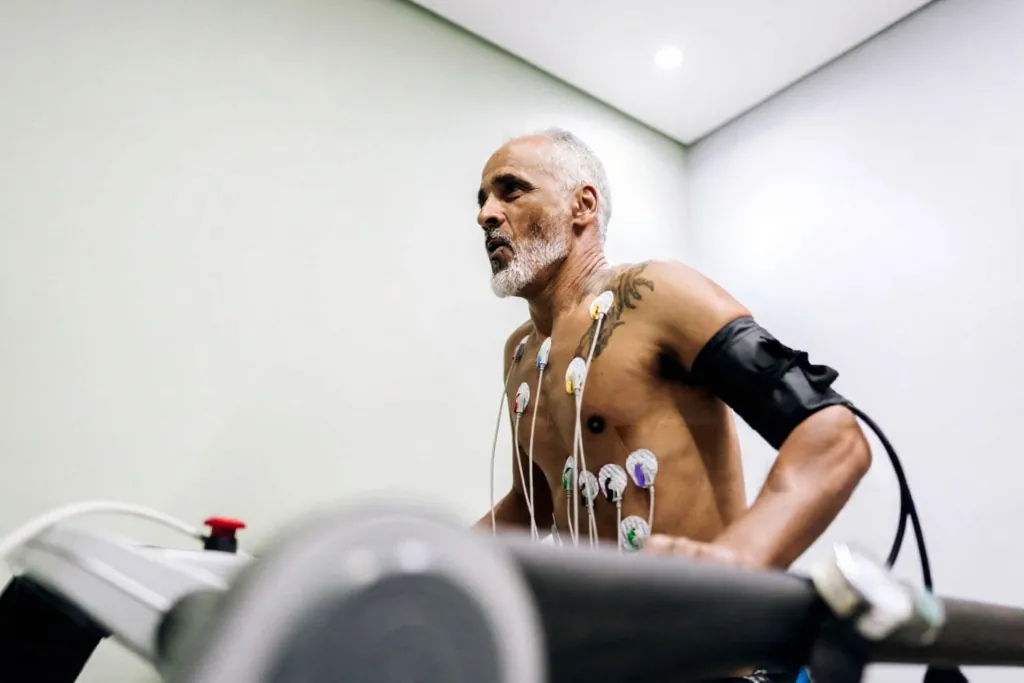
- 12 min read

Lose Your Edge, Risk Your Heart 2025
A 40-year study proves men start moving less, long before heart disease hits. Slow slide few men see coming, and what it really takes to fight it.
You’re 45 years old. You skip the gym more often. Your weekend bike rides turn into Netflix binges. You tell yourself it’s just work stress, getting older, normal stuff.
Wrong.
Your body might be warning you about a heart attack that’s still a decade away. And once that cardiac event hits? Good luck getting back to where you were.
This isn’t your typical scare story. It’s straight out of a bombshell JAMA Cardiology study from July 2025 that tracked over 3,000 people for nearly four decades.
The 12-Year Countdown Nobody Talks About

CARDIA just dropped some brutal truth: adults who develop heart disease show declining physical activity starting 12 years before their diagnosis. Not one year. Not five. Twelve damn years.
Think about that timeline. If you have a heart attack at 55, your body started checking out when you were 43. Right around the time most guys convince themselves they’re “too busy” for regular exercise.
The study tracked 3,068 people from their mid-20s into their late 50s - that’s 34 years of data. These weren’t sick people. They started healthy. Average age at the start? Just 25 years old. Average fitness score? A solid 423 exercise units (EU), where 300 EU equals about 150 minutes of moderate cardio per week.
Here’s what should scare the hell out of you:
Physical activity starts its slow decline about 12 years before a cardiovascular event. Then about 2 years out? The decline hits turbo speed. Falls off a cliff. After the event? People who had heart problems were 78% more likely to have low activity levels compared to healthy controls.
The gap never closes. Ever.
The Long, Steady Slide That Kills You

By the numbers: that average 25-year-old with 423 EU? Activity dropped year after year, especially once they hit their thirties and forties. By age 40, most men were already below recommended levels.
I’ve had guys in the gym ask me why they don’t feel as strong after just turning 40. Turns out there’s hard data to back it up. Not just about looking less ripped, but actually moving less, gradually, then all at once.
Ask yourself: did you move more last year than the year before? For most, the answer’s no.
The researchers matched 236 people who suffered nonfatal heart disease with nearly identical controls who didn’t - matched by age, sex, and race. That’s when the real pattern emerged.
Guys about to get heart disease didn’t magically start exercising more out of fear, they dialed it back, sometimes without even knowing it. Makes sense if you think about a buddy who starts skipping rec league games, or someone who can’t keep up on bike rides “because work got crazy.” Sure, life gets busy. But so does dying.
Your Exercise Score Is Trying to Tell You Something
Ever noticed older men cruising the mall at 8am, counting steps on their Fitbits? They’re the exception, not the rule. Most fade out slowly, one missed workout at a time.
The healthy people in this study? Their activity dropped too as they aged. That’s normal. But the people heading toward heart disease? Different story entirely.
I’ve seen this pattern play out with guys I know. They start strong in their 30s. By 45, they’re making excuses. By 50, they’re on statins. By 55, they’re getting stents. The whole time, their declining gym attendance was basically a countdown timer to cardiac problems.
Remember: Men in this study didn’t realize how much their activity was tanking - until one morning, they woke up in the ER. You don’t want to be the guy who says, “Yeah, I used to play ball every Saturday,” and then finds out it’s been five years since your last real game.
Black Women Get Screwed, Black Men Start Strong Then Crash

Here’s data that should be front-page news but isn’t.
Black women consistently showed the lowest physical activity levels throughout the entire study. After a cardiovascular event? Their odds of staying inactive soared to 4.52 - nearly five times higher than their matched peers. If you’re part of that demographic, the system’s not just failing you; it’s almost designed to.
Black men? Started with the highest activity of any group. But by their 40s, their scores dropped to match white men. By 50, they’d fallen below. That sustained decline is brutal to watch in the data.
As for odds after heart disease? Black men had 1.72 times higher risk of low activity, white men 0.92 (nearly no difference). White women? 2.86 times higher risk. Though interestingly, white women trended lower than men in early years but rebounded in their 50s. Personally, I think they are prepping to look good after the divorce they are planning.
These aren’t just numbers. This is systematic failure to address real health disparities. And before someone emails me about “socioeconomic factors” - yes, I know. That’s the point. The system is broken.
The Death Spiral After Your First Event

Let’s say you ignore all the warning signs. You have your heart attack or stroke. You survive. Great. Yay.
Now what?
After a CVD event, the activity gap between patients and healthy controls actually grew larger. Compare yourself to a friend who’s had a heart scare - betcha he talks about “getting back,” but he never does. The gap between the sick and healthy crew stayed wide open. Odds ratio for staying below recommended activity? 1.78 times greater if you’ve had heart disease, even after you supposedly “recover.”
Even the lead researcher was shocked. Dr. Yariv Gerber from Tel Aviv University said:
“I expected to see a substantial increase in physical activity post-CVD, as a kind of ‘wake-up call,’ but that didn’t happen. The persistent gap between cases and controls, even years after the event, really stood out.”
Think about that. The guy running this study thought heart attacks would motivate people to exercise. Nope. Not even close.
Think about the psychology here. You’re scared about failing again. Your doctor gives you generic advice - “Walk 30 minutes a day!” as if that’s some golden ticket. Your family treats you like you’re made of glass. Meanwhile, your already-compromised cardiovascular system is deteriorating faster because you’re moving even less than before.
It’s a death spiral. And cardiac rehab programs? Most guys skip them. Too many serve up a soup of platitudes. “Eat more greens.” “Take your pills.” “Use the treadmill.” What men really need? Tough honesty: You’re probably not going to recover without relentless, personalized expensive coaching.
I know men who’ve had heart attacks and skipped their own cardiac rehab. That’s how bad compliance is.
Stop Thinking You’re the Exception
Don’t let comfort or nostalgia fool you. Odds are, your activity’s not just slowly declining - it’s nosediving. This isn’t just about you. It’s about every guy in the room, especially if you’re over 40.
You know that friend who used to play basketball every week and now just watches it on TV? He’s on the list. The guy who sold his bike because he “doesn’t have time anymore”? List. Your brother who used to lift weights but now just talks about his glory days? List. You get it.
The crazy part? Physical activity steadily declined from young adulthood into middle age, then plateaued. So there’s a floor. People hit a certain level of inactivity and stay there. Usually right around the “I take the stairs sometimes” level of movement.
That’s not enough. Not even close.
What Actually Works (No BS Version)
Forget the fancy protocols. Here’s what you actually need to do:
Get tested early. Don’t wait for your 45th birthday physical. Annual fitness screening, not just cholesterol numbers, is your real indicator. Pay for and get a CT scan, see how bad the plaque and calcification is, then get a Echo TTE (Transthoracic Echocardiogram). Sunnybrook in Toronto has the newest machines, yes this matters.
Track weekly totals using actual numbers. The 300 EU (or 150 minutes of moderate-to-vigorous activity) is the benchmark, but higher is better. Don’t measure activity in vague “minutes.” Get specific.
Use aggressive reminders and real social pressure. Join leagues, set up group rides, compete on apps. If you’re older, hire a coach before you need a cardiologist. Bring back your competitive streak. Gamify your step counts. Compete against your old numbers. Get rehab first if you have old injuries, you do not need to hit it, get injured again and be out for even longer.
Pick something you can do 3-4 times a week minimum. I don’t care if it’s lifting, running, swimming, cycling or aggressively gardening. Just move with intensity for 30-45 minutes. Get your heart rate up to where conversation becomes difficult.
Can’t do 30 minutes? Start with 10. Can’t run? Walk fast. Can’t walk fast? Walk slow. But track it. Write it down. Because the moment you stop tracking is the moment you start declining.
For Black men and women: advocate hard for tailored rehab. Standard programs don’t cut it. Push for teams that actually know your situation. If they seem clueless, fire them. I have friends who switched clinics and doubled their activity in months.
Post-cardiac event? Don’t believe the “one size fits all” talk. Demand measurable recovery goals and accountability. Grab something like a Garmin or Apple Watch and set concrete goals. Otherwise, that plateau is your new normal.
The guys I know who’ve beaten the odds? They’re not special. They just never stopped moving. One friend had a minor heart attack at 52. He was back in the gym within 6 weeks (with clearance). Now at 58, he’s fitter than he was at 40. But he’s the exception.
Most guys have their event and basically give up. Don’t be most guys.
Update 2025: The Post-COVID Reality Check
Here’s my big frustration. Even with studies like this from JAMA Cardiology, most mainstream recommendations pretend men suddenly transform their habits after heart issues. They don’t, and this research proves it - in cold, hard numbers.
We’re also seeing something new. Post-COVID patients showing similar exercise decline patterns but compressed into months, not years. Long COVID basically fast-forwards this whole process. I am super guilty of this, I didn’t get the covid 20, I lost 10. But last year 2 injuries (old ones, so I am speaking from experience when I say get rehab)resurfaced and I gained 25lbs fat lost 22lbs muscle.
Young guys who got COVID in 2020? Some of them now have the exercise capacity of men 20 years older. Their trajectory toward heart disease just went from a 12-year timeline to maybe 5 years. Nobody’s talking about this enough.
The stats from CARDIA aren’t going to change unless guys start calling out bland medical advice and demanding actual solutions.
The Part Nobody Wants to Admit
Here’s what kills me about this research: we’ve known exercise prevents heart disease for decades. This isn’t news. But now we know your body starts telegraphing the problem over a decade in advance.
Those excuses feel real - “work, family, my knees” - right up until they’re the reason for a doctor’s diagnosis. The numbers don’t lie.
The study’s median follow-up was 34 years. That’s not some quick observational BS. That’s tracking real people through real life for longer than most marriages last.
The pattern is crystal clear: exercise drops, heart disease follows. Not might follow. Not sometimes follows. Follows.
The Bottom Line
Your body is giving you a 12-year warning. That’s generous as hell. Most diseases give you months, maybe a year if you’re lucky. Heart disease gives you over a decade.
Track your activity religiously. Your next game, ride, or run might be the most important workout of your life.
You can argue with a lot of health advice. You can’t argue with 34 years of data showing the same thing over and over: 236 people who had heart attacks and strokes all showed the same pattern of declining activity years before their events.
So here’s your choice. Keep making excuses about why you can’t exercise, and join those 236 people in the study. Or get off your butt and move.
Your 12-year countdown might have already started. The only question is whether you’re going to do something about it.
Was this article helpful? Let us know!